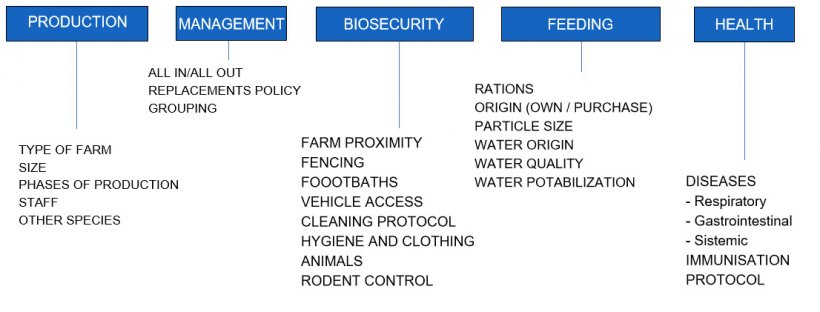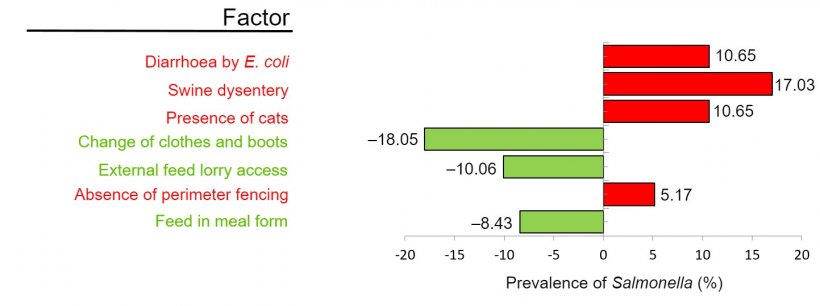Salmonella spp. is the main zoonosis transmitted by pigs. Pork has traditionally been considered, after poultry and eggs, as the third most frequent cause of salmonellosis in humans. In fact, it is estimated that between 20-40% of cases of salmonellosis are associated with the consumption of pork. Therefore, control in this species is still an unmet need, even more so compared to the success and effectiveness of poultry control programs. Although at the legislative level no action has been taken for years regarding the control of the infection, the pathogen remains relevant, both because of the research being carried out and because of the demands of the industry, that demands a solution to control the disease.
One of the greatest challenges presented by the control of Salmonella is its complex epidemiology, which involves multiple factors that influence the incidence of infection. Studies of risk factors have been a tool frequently used to clarify which variables of management, production, biosecurity or feeding can influence the epidemiology of Salmonella infection. With this idea in mind, we designed a study to analyse the risk factors associated with Salmonella infection in Irish pig farms (Figure 1). One of the novelties of the study with respect to previous works was the use of data from the Serology Farm Monitoring Program. Ireland has a mandatory monitoring program for farms with fattening pigs in which serum samples are collected in the slaughterhouse on a monthly basis for the categorization of the farms. The annual prevalence (in 2014) included 30 variables collected through a questionnaire to determine those factors associated with farms with a high prevalence of Salmonella and those linked to seronegative farms. A questionnaire was completed containing 33 questions about the characteristics of the farm, management, feeding, biosecurity and health status (Figure 1).


Figure 1. Topics included in the questionnaire administered in 61 Irish farms included in the Salmonella monitoring program.
Figure 2 represents the factors associated with Salmonella infection in this study. Farm biosecurity was highlighted as one of the factors associated with the presence of infection. Two actions related to accessing the farm were associated with a lower seroprevalence: access restrictions within the perimeter of the farm for the food truck, and change of footwear for staff and visits when entering the farm. These two measures aim to limit the possibility of introducing unwanted pathogens on the farm and this study shows the advantages of their strict implementation in the case of Salmonella. Similarly, the study data showed that farms without a perimeter fence had a higher risk of having high levels of seroprevalence. Another factor associated with the persistence of Salmonella on the farm was the presence of cats. Cats are often used to control mice on farms. Rodents, and specifically mice, are hosts of Salmonella. If the mice are infected, they can transfer the infection to the farm cats, so that they turn into Salmonella carriers for long periods of time.

Figure 2. Factors associated with the prevalence of Salmonella according to the study of risk factors. Green: protective factors; Red: factors that increase the risk of increasing seroprevalence (Adapted from Argüello et al. 2018.)
Nutrition is one of the key factors in the control of Salmonella. In a similar way to previous studies, this work showed that feed in meal form reduces the risk of infection. Meal diets improves the health of the gut microbiota and increases resistance to pathogens such as Salmonella.
One of the most novel aspects of this work was the detailed study of the sanitary status of the farm, with a detailed questionnaire of the diseases and vaccinations of each participant in the study. Two diseases, swine dysentery (Brachyspira hyodysenteriae) and diarrhoea due to Escherichia coli were associated with farms with a high seroprevalence. This data reflects the importance of the enteric complex in the perpetuation of diseases such as porcine salmonellosis, which is aggravated in the presence of other intestinal pathogens.
The conclusion of this study is that the results show that Salmonella infection in pigs is multifactorial, and they also stress the need to simultaneously include different control strategies, including, but not limited to feeding, biosecurity, and control of other diseases.
Adapted from: Argüello H, Manzanilla EG, Lynch H, Walia K, Leonard FC, Egan J, Duffy G, Gardiner GE, Lawlor PG. 2018. Surveillance Data Highlights Feed Form, Biosecurity, and Disease Control as Significant Factors Associated with Salmonella Infection on Farrow-to-Finish Pig Farms. Front Microbiol. 15;9:187. doi: 10.3389/fmicb.2018.00187. eCollection 2018.





